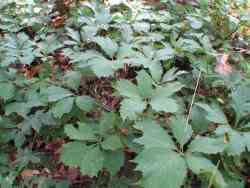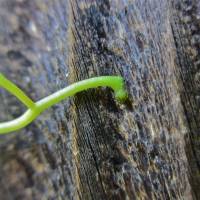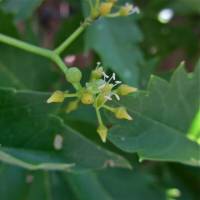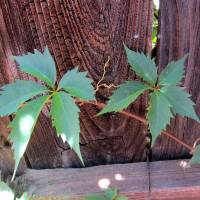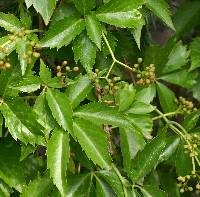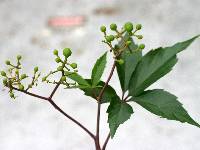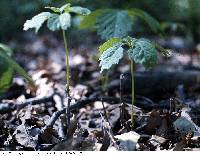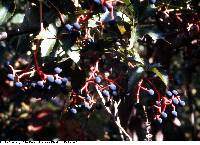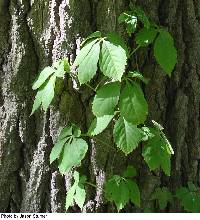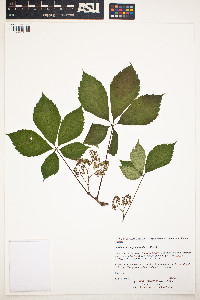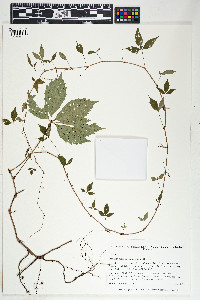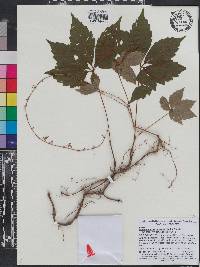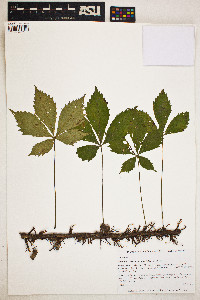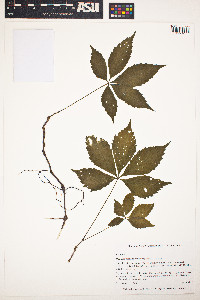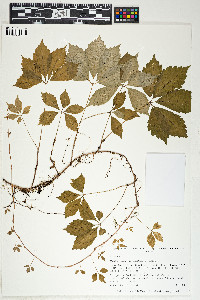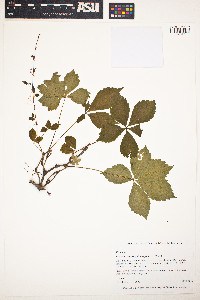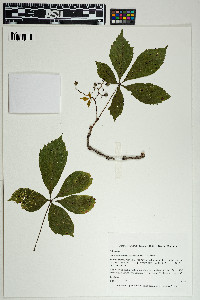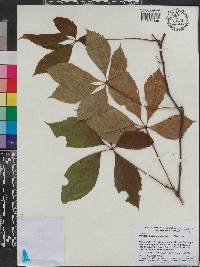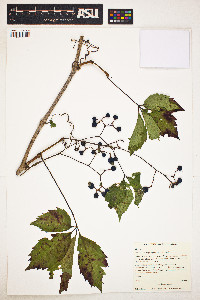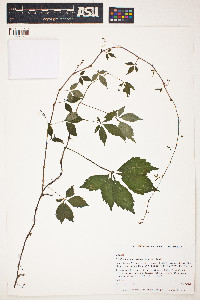Search
Parthenocissus quinquefolia
|
|
|
|
Family: Vitaceae
Virginia creeper
[Ampelopsis hederacea (Ehrh.) DC., moreAmpelopsis hederacea var. murorum Focke, Ampelopsis latifolia (Roxb.) Tausch, Ampelopsis quinquefolia (L.) Michx., Hedera quinquefolia L., Parthenocissus hirsuta (Pursh) Graebn., Parthenocissus inserta (A. Kerner) Fritsch, Parthenocissus quinquefolia var. hirsuta (Pursh) Planch., Parthenocissus quinquefolia var. murorum (Focke) Rehder, Parthenocissus quinquefolia var. saintpaulii (Koehne ex Graebn.) Rehder, Psedera quinquefolia (L.) Greene, Psedera quinquefolia var. murorum (Focke) Rehder, Vitis inserta Kern., Vitis quinquefolia (L.) Lam.] |
Perennial woody vine to 20 m long Stem: high-climbing, reddish brown and lightly hairy when young, becoming dark brown and rough with fibrous inner bark and aerial roots. Leaves: alternate, palmately compound with five leaflets, and a long, grooved stalk. Leaflets are stalkless or short-stalked, dull green above, paler with a slight waxy whitish coating beneath, 6 - 12 cm long, elliptic to inversely egg-shaped, tapering to the tip and base, toothed mostly above the center. Fall color bright red to purplish red, leaves falling shortly after first frost. Inflorescence: borne opposite the leaves on current season's growth, 6.5 - 12.5 cm long, with a zigzag central axis. Flowers: 25 to 200 per inflorescence, greenish, having five stamens and five petals. Fruit: a thin-fleshed berry, red-stalked, nearly black, about 6 mm long, spherical but slightly flattened, with two to four seeds. Seeds are shiny dark brown, 3 mm long, and spherical to egg-shaped. Tendrils: 3.8 - 5 cm long, highly branched, ending in adhesive disks. Tendrils and aerial roots only form on climbing plants, not those creeping along the ground. Similar species: Parthenocissus tricuspidata has leaves with either three lobes or three leaflets. Parthenocissus vitacea has tendrils that lack adhesive disks and inflorescences that fork into two or three main branches but lack a central axis. Flowering: mid July to mid August Habitat and ecology: Very common in woodlands, often climbing up trees and sometimes covering the forest floor of unburned oak woodlands. Occurence in the Chicago region: native Notes: Birds eat the fruit of this species, while deer feed on the leaves, stems, and fruit. Honeybees are attracted to the flowers. Parthenocissus quinquefolia is desired in landscapes for its fall color and is often used to cover fences, trellises, and walls. Etymology: Parthenocissus comes from the Greek words parthenos, meaning virgin, and kissos meaning ivy. Quinquefolia means five-leaved. Author: The Morton Arboretum High climbing vine, adhering to its support by numerous adhesive disks developing at the ends of the much branched tendrils; lvs long- petioled, the lfls dull green above, paler and slightly glaucous beneath, elliptic to obovate, 6-12 cm, abruptly acuminate, sharply serrate chiefly beyond the middle, cuneate to the base, sessile or on petiolules to 15 mm; infls terminal and from the upper axils, forming panicles usually longer than wide, with a well marked zigzag sympodial axis and divergent branches, the fls in terminal umbelliform clusters; frs nearly black, 6 mm; 2n=40. Moist soil; Me. to O., Io., and Nebr., s. to Fla. and Tex. June. (Psedera q.; P. hirsuta) Gleason, Henry A. & Cronquist, Arthur J. 1991. Manual of vascular plants of northeastern United States and adjacent Canada. lxxv + 910 pp. ©The New York Botanical Garden. All rights reserved. Used by permission. Welsh et al. 1993, Kearney and Peebles 1969, Carter 2012, Heil et al 2013 Duration: Perennial Nativity: Native Lifeform: Vine General: Woody vines to 5 m tall or more, supported by tendrils with 3-8 branches, these tendril branches tipped with adhesive disks, allowing the plant to climb stone and brick structures. Leaves: Winter-deciduous; palmately compound with 3-7 leaflets on distinct petioles; leaflet blades 3-15 cm long, 2-8 cm wide, oblong-lanceolate with coarsely serrate margins, pale green and dull above, glaucous beneath. Flowers: Green and inconspicuous, arranged in a cyme with a prolonged central axis that zig-zags, the flowers clustered and arising laterally from the axis, forming a paniculate inflorescence with up to 200 flowers; flowers unisexual; calyx saucer-shaped, minutely 5-toothed; petals 1-2 mm. Fruits: Blackish berries, 5-7 mm diameter. Ecology: Found as an escaped cultivar, persisting around old buildings and abandoned farms, especially in damp riparian areas, from 3,000-7,500 ft (914-2286 m); flowers May-July. Distribution: Native to the eastern US; commonly planted as an ornamental in the western US. Notes: There is some consideration to be made here if the records are made near human habitation or not, as this species is largely cultivated and only exists in limited areas where it has escaped. Appears quite similar to the native P. vitacea, which has shiny leaves, tendrils that generally lack adhesive disks and flattened tips, and cymes that are dichotomously branched. In contrast, P. quinquefolia has dull green leaves, tendrils with adherent disks and flattened tips, and inflorescences with well developed, zig-zagging central axes. Western specimens were traditionally labeled as P. inserta, but this name is simply a synonym for the eastern species P. quinquefolia. Ethnobotany: Taken for jaundice, as an antidote for poison sumac, for urination problems, applied as a poultice to reduce swellings, and pink paint was made from the berries for ceremonial purposes; the fruits were collected and eaten like grapes and the root was cooked and eaten; care should be taken, however, as there is some evidence that the fruit contains toxic levels of oxalic acid and poisoning deaths have been attributed to it. Etymology: Parthenocissus comes from Greek parthenos, a virgin and kissos, ivy; quinquefolia translates to five-parted leaf. Synonyms: Parthenocissus inserta and many others, see Tropicos Editor: SBuckley 2010, AHazelton 2015 |
|
|
|


